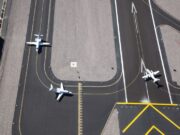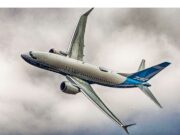
General aviation (GA) in Australia suffered 149 accidents in 2014, the highest number in 10 years. Eleven of those accidents were fatal, the lowest number in 10 years, according to Aviation Occurrence Statistics: 2005–2014, published in December by the Australian Transport Safety Bureau (ATSB). Fifteen of the 149 accidents resulted in serious injuries, the report said. The GA accidents resulted in 17 fatalities and 20 serious injuries (Table 1).
Overall, GA in Australia experienced 1,406 occurrences in 2014, of which 1,256 were incidents, down from 1,399 incidents in 2013, and from a 10-year peak of 1,795 in 2009. Of the 2014 occurrences, 118 were categorized as serious incidents, 15 as serious injury accidents and, as noted, 11 as fatal accidents. In 2013, there were 186 serious incidents, six serious injury accidents, 15 fatal accidents and 90 total accidents. The worst year in the past 10 for total accidents was 2010, when there were 127. The worst year for fatal accidents in the study period was 2008, when there were 22.
ATSB defines an occurrence as an accident or an incident. It defines an accident as an occurrence involving an aircraft in which a person dies or suffers a serious injury; the aircraft is destroyed or is seriously damaged; or any property is destroyed or seriously damaged. An incident is defined as an occurrence other than an accident associated with the operation of an aircraft that affects or could affect the safety of operation. A serious incident is one involving circumstances indicating that an accident nearly occurred, and a serious injury is one that requires, or would require, admission to a hospital within seven days after the injury was suffered.
| 2005 | 2006 | 2007 | 2008 | 2009 | 2010 | 2011 | 2012 | 2013 | 2014 | |
|---|---|---|---|---|---|---|---|---|---|---|
| GA = general aviation
*Includes VH- and foreign-registered aircraft Source: Australian Transport Safety Bureau |
||||||||||
| Incidents | 1,546 | 1,654 | 1,597 | 1,608 | 1,795 | 1,552 | 1,503 | 1,407 | 1,399 | 1,256 |
| Serious incidents | 57 | 70 | 93 | 103 | 95 | 132 | 137 | 159 | 186 | 118 |
| Serious injury accidents | 4 | 8 | 7 | 16 | 8 | 15 | 14 | 17 | 6 | 15 |
| Fatal accidents | 16 | 19 | 12 | 22 | 16 | 13 | 16 | 20 | 15 | 11 |
| Total accidents | 118 | 91 | 117 | 126 | 117 | 127 | 116 | 112 | 90 | 149 |
| Serious injuries | 5 | 13 | 9 | 23 | 10 | 19 | 23 | 20 | 8 | 20 |
| Fatalities | 21 | 34 | 21 | 34 | 16 | 16 | 28 | 29 | 24 | 17 |
ATSB categorizes occurrences by operational type. Commercial air transport includes high capacity regular public transport (RPT) flights, low capacity RPT flights, charter flights and medical transport. High capacity refers to aircraft that are certified as having a maximum capacity exceeding 38 seats, or having a maximum payload capability that exceeds 4,200 kg (9,259 lb). GA includes aerial work operations, flight training, and private, business and sports aviation, which includes gliding. In previous editions of the report, medical transport was grouped with aerial work, but with this edition, it has been grouped with commercial air transport, which has led to a decrease in the contribution aerial work makes to the overall GA statistics, ATSB said in the report.
Recreational aviation involves aircraft used for recreational flying that are registered by a recreational aviation administration organization (RAAO). Remotely piloted aircraft (RPA) operations include all operations using remotely piloted aircraft approved by Australia’s Civil Aviation Safety Authority (CASA). This edition of the report marks the first time that occurrence statistics regarding RPAs have been included; ATSB attributed their inclusion to an increase in RPA involvement in reported occurrences.
In the 10 years from 2005 through 2014, 254 aircraft were involved in fatal accidents in Australia, resulting in 374 fatalities. Of those accidents, 160 involved GA aircraft registered with CASA (VH-registered), resulting in 240 fatalities. Private/business aircraft accounted for 83 of those accidents, and aircraft used in aerial work, such as agriculture or mustering (cattle herding with aircraft), were involved in 48 accidents.
Non-registered recreational aircraft, including airplanes, weight-shift hang gliders, trikes, paragliders and powered parachutes, and gyrocopters, accounted for 80 of the 254 accidents and 98 of the 374 fatalities.
Commercial air transport accounted for 14 of the fatal accidents and 36 of the fatalities during the 10-year period, with low-capacity RPT accounting for two accidents and 17 fatalities, and charter flights accounting for 12 accidents and 19 fatalities. High capacity RPT, medical transport and foreign-registered air transport did not suffer any fatal accidents in Australia during the period (Figure 1).
Figure 1 — All Commercial Air Transport Occurrences*
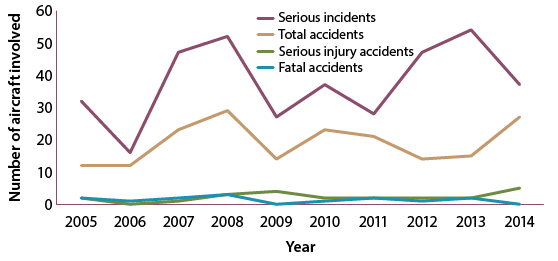
*Includes VH- and foreign-registered aircraft
Source: Australian Transport Safety Bureau
The number of reportable safety incidents in commercial air transport increased over the 10-year period, which ATSB attributed to an increase in flying activity by most types of air transport and to the operators’ greater awareness of their reporting requirements. ATSB added that around 30 percent of all commercial air transport incidents reported involved bird strikes. In 2014, there were 4,308 incidents, down slightly from the previous year’s 4,402, but 15 percent higher from the 10-year average of 3,648 (Table 2).
| 2005 | 2006 | 2007 | 2008 | 2009 | 2010 | 2011 | 2012 | 2013 | 2014 | |
|---|---|---|---|---|---|---|---|---|---|---|
| *Includes VH- and foreign-registered aircraft
Source: Australian Transport Safety Bureau |
||||||||||
| Incidents | 3,332 | 3,081 | 3,152 | 3,337 | 3,162 | 3,477 | 4,002 | 4,222 | 4,402 | 4,308 |
| Serious incidents | 32 | 16 | 47 | 52 | 27 | 37 | 28 | 47 | 54 | 37 |
| Serious injury accidents | 2 | 0 | 1 | 3 | 4 | 2 | 2 | 2 | 2 | 5 |
| Fatal accidents | 2 | 1 | 2 | 3 | 0 | 1 | 2 | 1 | 2 | 0 |
| Total accidents | 12 | 12 | 23 | 29 | 14 | 23 | 21 | 14 | 15 | 27 |
| Serious injuries | 2 | 0 | 1 | 15 | 6 | 2 | 2 | 2 | 4 | 7 |
| Fatalities | 18 | 2 | 2 | 6 | 0 | 2 | 2 | 1 | 3 | 0 |
In 2014, there were 27 accidents involving commercial air transport, of which 23 involved charter aircraft. The 10-year average of commercial air transport accidents is 19 per year. The 37 serious commercial air transport incidents in 2014 was slightly below the category’s 10-year average of 38 per year, and represented a significant improvement from 2012 and 2013, which saw substantial increases from 2011. The number of incidents involving VH-registered high capacity RPT has risen about 56 percent in the last 10 years, which is consistent with a 52 percent increase in departures, ATSB said (Figure 2). “Provided these trends remain constant, the number of reported incidents would double very 14 years, with departures doubling every 15 years,” according to the report. No fatalities involving VH-registered high capacity RPT aircraft have occurred since 1975. There were 3,214 incidents involving high capacity RPT aircraft in 2014, which is 22 percent higher than the 10-year average of 2,491 per year. The number of serious incidents, however, which had jumped to 23 in 2013, up from 13 in 2012, returned to 13 in 2014. The average per year over the last 10 years is 14.
Figure 2 — Incidents Involving VH-Registration High-Capacity RPT Aircraft
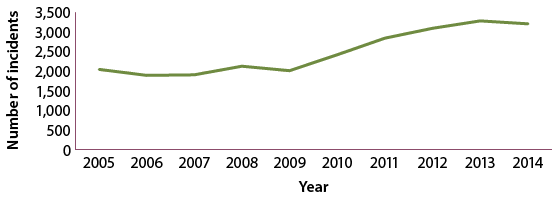
RPT = regular public transport
Source: Australian Transport Safety Bureau
The number of incidents reported involving low capacity RPT aircraft has declined in the last 10 years, primarily due to a decline in flying hours and departures, ATSB said (Figure 3). The report said the decline is a combined result of Australia’s mining boom, which drove demand for larger aircraft to move more people to regional cities and mining communities, regional airlines using larger aircraft and additional regional travel options provided by high capacity RPT operators.
Figure 3 — Incidents Involving VH-Registration Low-Capacity RPT Aircraft
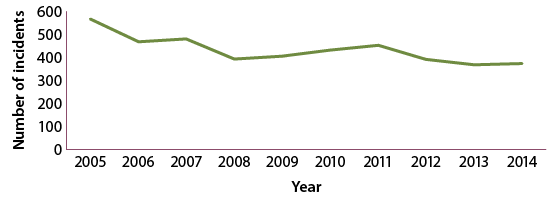
RPT = regular public transport
Source: Australian Transport Safety Bureau
Incidents involving foreign-registered air transport operations remained steady across the 10-year period, and no foreign aircraft operating as air transport in Australia has been involved in fatal or serious injury accidents in the last 10 years, ATSB said. There were 162 incidents involving foreign registered aircraft in Australia in 2014, down from 188 in 2013, and there were one accident and two serious incidents.
GA is considered to be all flying activities of VH-registered aircraft outside of commercial air transport, excluding recreational aircraft that are administered by RAAOs and do not have VH registration. GA accounts for more than half of all aircraft movements across Australia and about 40 percent of the total hours flown by Australian-registered aircraft. Despite the size of the GA fleet and the number of departures, comparatively few occurrence reports are sent to ATSB. In 2014 there were 1,256 incidents and 149 accidents reported.
ATSB said that a major challenge is the lower level of awareness in the GA community of the need to report safety matters, and what constitutes a reportable safety matter. In fact, underreporting has been identified as one of the ATSB’s SafetyWatch priorities for improving transport safety in Australia. ATSB said in the report that future amendments to the Transport Safety Investigation Regulations are intended to clarify what the industry needs to report in order to make reporting “clearer and less onerous” for pilots and operators.
In 2014, there were 17 occurrences involving RPAs, more than double the eight reported in 2013. ATSB’s report contains data on RPAs only back to 2011. Of 2014’s occurrences, three were classified as accidents and three as serious incidents. The other 11 were incidents.
The three accidents included a triathlon participant being injured in a collision with an RPA that was filming the race. The collision occurred after the operator lost control of the RPA. In the other two accidents, an RPA collided with terrain soon after takeoff at a golf club and was substantially damaged, and an RPA conducting aerial survey operations was substantially damaged in a collision with terrain after the operator lost control of the aircraft.

